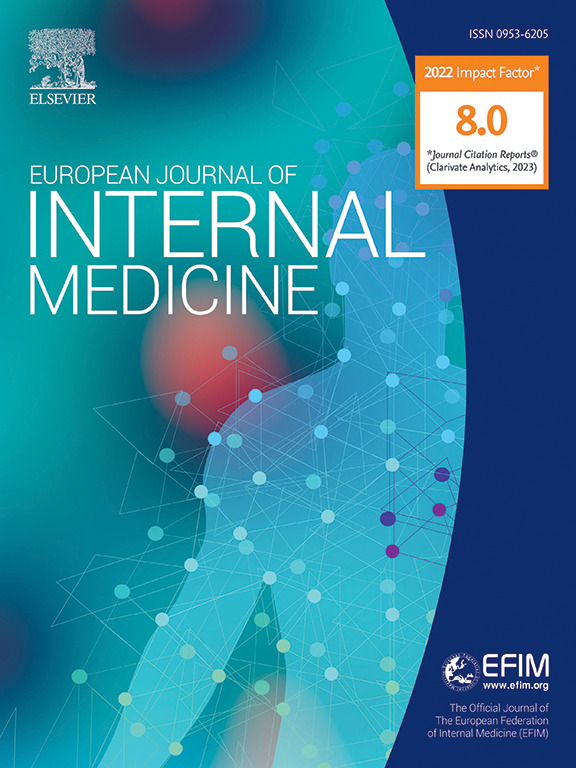External validation of a prognostic score to identify low-risk outpatients with acute deep venous thrombosis in the lower limbs
IF 5.9
2区 医学
Q1 MEDICINE, GENERAL & INTERNAL
引用次数: 0
Abstract
Background
Current clinical guidelines suggest home treatment for patients diagnosed with acute deep venous thrombosis (DVT). A prognostic score has been proposed to identify low-risk patients; however, its validation remains limited.
Method
This prospective observational study aimed to externally validate the prognostic score in selecting low-risk outpatients with acute DVT in the lower limbs. Consecutive outpatients diagnosed with acute DVT in a tertiary hospital were included. The score included 6 variables: heart failure, kidney failure, recent major bleeding, altered platelet count, immobilization, and cancer. The primary outcome was the incidence of a composite outcome, including confirmed diagnosis of PE, major bleeding, or all-cause death at 7 days. Patients meeting zero criteria were considered low risk.
Results
Among the 1035 patients included, 485 (46.9 %) met zero criteria. Of these, 0.2 % (95 % CI 0.0–1.1 %) and 0.4 % (95 % CI, 0.0–1.5 %) patients experienced the composite outcome at 7 and 30 days, respectively. Among patients who met 1 or more criteria for admission, 344 patients (62.5 %) were discharged. Among these, the composite outcome at 7 and 30 days occurred in 2 (0.6 %) and 5 (1.4 %) patients, respectively. The C-statistics of the score were 0.68 (95 % CI, 0.57–0.79) and 0.69 (95 % CI, 0.64–0.76) at 7 and 30 days, respectively.
Conclusion
This study demonstrates the efficacy of the prognostic score in identifying low-risk outpatients with acute DVT. It also suggests that a considerable proportion of patients with acute DVT may benefit from outpatient treatment despite having some risk criteria, highlighting the potential for optimizing ambulatory care pathways.
外部验证用于识别急性下肢深静脉血栓低风险门诊患者的预后评分。
背景:目前的临床指南建议对确诊为急性深静脉血栓(DVT)的患者进行居家治疗。有人提出了一个预后评分来识别低风险患者,但其验证仍然有限:这项前瞻性观察研究旨在从外部验证预后评分在选择下肢急性深静脉血栓形成低风险门诊患者方面的有效性。研究纳入了在一家三甲医院确诊为急性深静脉血栓的连续门诊患者。该评分包括 6 个变量:心力衰竭、肾衰竭、近期大出血、血小板计数改变、固定和癌症。主要结果是综合结果的发生率,包括确诊为 PE、大出血或 7 天后全因死亡。符合零标准的患者被视为低风险患者:在纳入的 1035 名患者中,有 485 人(46.9%)符合零标准。其中,分别有 0.2 %(95 % CI,0.0-1.1 %)和 0.4 %(95 % CI,0.0-1.5 %)的患者在 7 天和 30 天后出现综合结果。在符合一项或多项入院标准的患者中,有 344 名患者(62.5%)已经出院。其中,分别有 2 名(0.6%)和 5 名(1.4%)患者在 7 天和 30 天后出现综合结果。在 7 天和 30 天时,该评分的 C 统计量分别为 0.68(95 % CI,0.57-0.79)和 0.69(95 % CI,0.64-0.76):这项研究证明了预后评分在识别低风险急性深静脉血栓门诊患者方面的有效性。研究还表明,相当一部分急性深静脉血栓患者尽管有一定的风险标准,但仍可从门诊治疗中获益,这凸显了优化非住院治疗路径的潜力。
本文章由计算机程序翻译,如有差异,请以英文原文为准。
求助全文
约1分钟内获得全文
求助全文
来源期刊
CiteScore
9.60
自引率
6.20%
发文量
364
审稿时长
20 days
期刊介绍:
The European Journal of Internal Medicine serves as the official journal of the European Federation of Internal Medicine and is the primary scientific reference for European academic and non-academic internists. It is dedicated to advancing science and practice in internal medicine across Europe. The journal publishes original articles, editorials, reviews, internal medicine flashcards, and other relevant information in the field. Both translational medicine and clinical studies are emphasized. EJIM aspires to be a leading platform for excellent clinical studies, with a focus on enhancing the quality of healthcare in European hospitals.

 求助内容:
求助内容: 应助结果提醒方式:
应助结果提醒方式:


